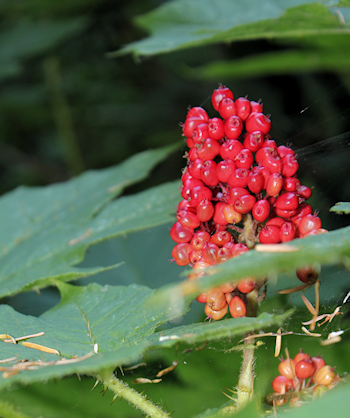Devil’s Club Decorates Old Growth Forests in Late Summer
Devil’s club or devil’s walking stick is a large shrub native to the cool moist conifer forests. It is found from Alaska to western Oregon and eastward to western Alberta and Montana.

Devil’s club usually grows in moist, dense forest habitats, and is most abundant in old growth conifer forests.
This native shrub always catches my eye in the late summer. Those clusters of showy red berries remind me of Christmas. I’ve found devil’s club along shaded streams around Salem and high up in the Cascades above Pamilia Lake and in many places in between. If it didn’t require moist, cool conditions, I’d be tempted to try to grow Devil’s club in my garden.
Appearance
Devil’s club generally grows up to about 5 ft tall but I’ve seen it reach more than 10 of 15 feet tall in old growth forests above Detroit Lake.
The large palmate leaves are about the size and shape of my outstretched hand and the lower veins and stems are clad in spines. I’ve never tested them, but the guides say the spines are brittle and break off easily.
The dense spines, height and the way the leaves grow almost parallel to the ground give the entire plant an almost “primordial” appearance.
The plants are slow growing and take many years to reach seed bearing maturity.
Uses
Native Americans used the plant both as food and medicine. The plant was traditionally used by Native Americans to make paints, and to treat a variety of tumors. The plant is harvested and used in a variety of ways, including lip balms, ointments, and herbal teas. Unfortunately, devil’s club is slow growing and therefore sensitive to human disturbance. It may take years to recover so be gentle with devil’s club if you come across it on your next outing.
